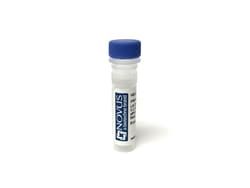ZAP70 Antibody (ZAP70/528) - IHC-Prediluted, Novus Biologicals™
Manufacturer: Novus Biologicals
Select a Size
| Pack Size | SKU | Availability | Price |
|---|---|---|---|
| Each of 1 | NBP248251-Each-of-1 | In Stock | ₹ 46,636.00 |
NBP248251 - Each of 1
In Stock
Quantity
1
Base Price: ₹ 46,636.00
GST (18%): ₹ 8,394.48
Total Price: ₹ 55,030.48
Antigen
ZAP70
Classification
Monoclonal
Conjugate
Unconjugated
Formulation
1.0mM PBS and 0.05% BSA with 0.05% Sodium Azide
Gene Symbols
ZAP70
Immunogen
Recombinant full-length human ZAP70 protein (Uniprot: P43403)
Purification Method
Protein A or G purified
Regulatory Status
RUO
Primary or Secondary
Primary
Test Specificity
ZAP70 is a 70kDa protein tyrosine kinase found in T-cells and natural killer cells. Control of this protein translation is via the IgVH gene. ZAP70 protein is expressed in leukemic cells of approximately 25% of chronic lymphocytic leukemia (CLL) cases as well.Anti-ZAP70 expression is an excellent surrogate marker for the distinction between the Ig-mutated (anti-ZAP70 negative) and Ig-unmutated (anti-ZAP70 positive) CLL subtypes and can identify patient groups with divergent clinical courses. The anti-ZAP70 positive Ig-unmutated CLL cases have been shown to have a poorer prognosis.
Content And Storage
Store at 4C.
Isotype
IgG2a κ
Applications
Immunohistochemistry (Paraffin)
Clone
ZAP70/528
Dilution
Immunohistochemistry-Paraffin
Gene Alias
70 kDa zeta-associated protein, EC 2.7.10, EC 2.7.10.2, SRKFLJ17679, STDFLJ17670, Syk-related tyrosine kinase, tyrosine-protein kinase ZAP-70, TZK, ZAP-70, zeta-chain (TCR) associated protein kinase (70 kD), zeta-chain (TCR) associated protein kinase 70kDa, zeta-chain associated protein kinase, 70kD
Host Species
Mouse
Molecular Weight of Antigen
70 kDa
Quantity
7 mL
Research Discipline
Adaptive Immunity, Cell Biology, Immunology, Protein Kinase, Signal Transduction, Tyrosine Kinases
Gene ID (Entrez)
7535
Target Species
Human
Form
Purified
Description
- ZAP70 Monoclonal specifically detects ZAP70 in Human samples
- It is validated for Immunohistochemistry, Immunohistochemistry-Paraffin.

